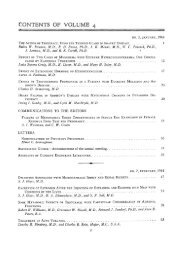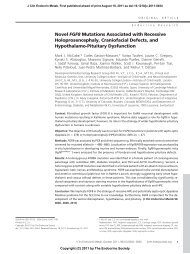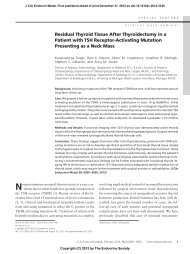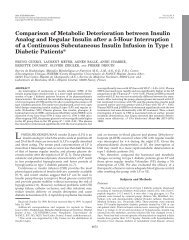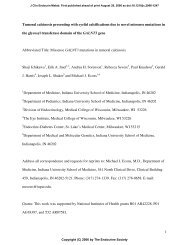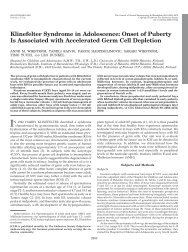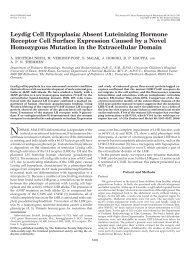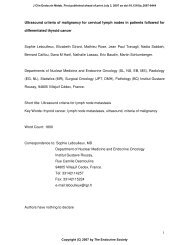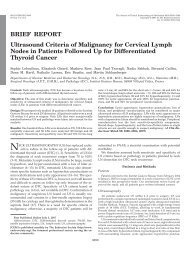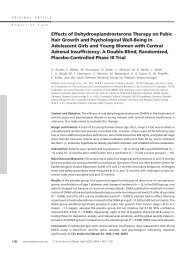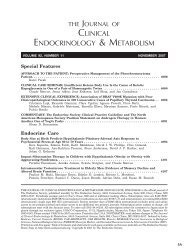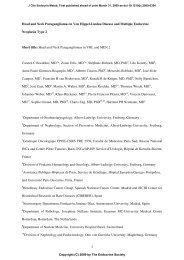Impaired glucose-induced glucagon suppression after partial ...
Impaired glucose-induced glucagon suppression after partial ...
Impaired glucose-induced glucagon suppression after partial ...
Create successful ePaper yourself
Turn your PDF publications into a flip-book with our unique Google optimized e-Paper software.
Introduction:<br />
In health, <strong>glucose</strong> homoeostasis is tightly regulated by the interplay of insulin and <strong>glucagon</strong><br />
secretion from pancreatic islets (1). Thus, under conditions of prolonged fasting, <strong>glucagon</strong><br />
levels rise, enhancing hepatic glycogenolysis and gluconeogenesis, whereas oral or<br />
intravenous <strong>glucose</strong> administration typically results in a decline in <strong>glucagon</strong> levels (2, 3).<br />
Furthermore, a brisk increase in <strong>glucagon</strong> secretion in response to falling blood <strong>glucose</strong><br />
concentrations provides a safeguard against the development of hypoglycaemia (2, 3).<br />
Alterations in <strong>glucagon</strong> secretion are frequently found in patients with type 2 diabetes (4).<br />
Thus, an insufficient <strong>suppression</strong> of <strong>glucagon</strong> levels <strong>after</strong> oral <strong>glucose</strong> or meal ingestion is<br />
thought to contribute significantly to the excessive hepatic <strong>glucose</strong> production in type 2<br />
diabetic patients (2, 5-7). Such abnormalities in <strong>glucagon</strong> secretion have been reported not<br />
only in patients with overt diabetes, but even in pre-diabetic subjects, such as individuals with<br />
impaired <strong>glucose</strong> tolerance (IGT) (8). However, the aetiology of these defects in <strong>glucagon</strong><br />
secretion is less clear, and two different explanations have been expounded. 1) The lack of<br />
<strong>glucose</strong>-<strong>induced</strong> <strong>suppression</strong> of <strong>glucagon</strong> levels in type 2 diabetes could represent a primary,<br />
possibly genetically determined, defect in alpha-cell function, independent of other metabolic<br />
abnormalities in such patients (9, 10). Such argumentation would imply that defects in<br />
<strong>glucagon</strong> secretion predispose subjects to developing type 2 diabetes (11). Against this, we<br />
and others have failed to detect any defects in alpha-cell function in individuals at high risk<br />
for developing type 2 diabetes, such as first-degree relatives (12, 13). 2) Alternatively, the<br />
lack of <strong>glucose</strong>-<strong>induced</strong> <strong>suppression</strong> of <strong>glucagon</strong> levels in patients with type 2 diabetes may<br />
be secondary to the deficit in beta-cell mass and the overall reduction in insulin secretion in<br />
such patients (14-16). In line with this hypothesis, a selective 50% reduction in beta-cell mass<br />
<strong>induced</strong> by the beta cytotoxin, alloxan, led to the development of both fasting and<br />
postprandial hyper<strong>glucagon</strong>aemia in Göttingen minipigs (17). Several experiments have<br />
suggested a close interaction of alpha- and beta-cells at the individual islet level (14-16).<br />
3



